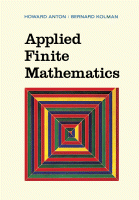Browse content
Table of contents
Actions for selected chapters
- Full text access
- Book chapterAbstract only
1 - SET THEORY
Pages 1-42 - Book chapterAbstract only
2 - COORDINATE SYSTEMS AND GRAPHS
Pages 43-82 - Book chapterAbstract only
3 - LINEAR PROGRAMMING (A GEOMETRIC APPROACH)
Pages 83-101 - Book chapterAbstract only
4 - MATRICES AND LINEAR SYSTEMS
Pages 102-154 - Book chapterAbstract only
5 - LINEAR PROGRAMMING (AN ALGEBRAIC APPROACH)*
Pages 155-200 - Book chapterAbstract only
6 - PROBABILITY
Pages 201-267 - Book chapterAbstract only
7 - STATISTICS
Pages 268-337 - Book chapterAbstract only
8 - APPLICATIONS
Pages 338-404 - Book chapterAbstract only
9 - COMPUTERS*
Pages 405-440 - Book chapterNo access
APPENDIX/TABLES
Pages 441-444 - Book chapterNo access
ANSWERS TO SELECTED EXERCISES
Pages 445-469 - Book chapterNo access
INDEX
Pages 471-475
About the book
Description
Applied Finite Mathematics presents the fundamentals of finite mathematics in a style tailored for beginners, but at the same time covers the subject matter in sufficient depth so that the student can see a rich variety of realistic and relevant applications. Applications in fields such as business, biology, behavioral sciences, and social sciences are included. Comprised of nine chapters, this book begins with an introduction to set theory, explaining concepts such as sets and union and intersection of sets as well as counting elements in sets. The next chapter deals with coordinate systems and graphs, along with applications of linear equations and graphs of linear inequalities. The discussion then turns to linear programming; matrices and linear systems; probability; and statistics. Examples of applications are given, including those of game theory, Markov chains, and probability. The final chapter is devoted to computers and programming languages such as FORTRAN. This monograph is intended for students and instructors of applied mathematics.
Applied Finite Mathematics presents the fundamentals of finite mathematics in a style tailored for beginners, but at the same time covers the subject matter in sufficient depth so that the student can see a rich variety of realistic and relevant applications. Applications in fields such as business, biology, behavioral sciences, and social sciences are included. Comprised of nine chapters, this book begins with an introduction to set theory, explaining concepts such as sets and union and intersection of sets as well as counting elements in sets. The next chapter deals with coordinate systems and graphs, along with applications of linear equations and graphs of linear inequalities. The discussion then turns to linear programming; matrices and linear systems; probability; and statistics. Examples of applications are given, including those of game theory, Markov chains, and probability. The final chapter is devoted to computers and programming languages such as FORTRAN. This monograph is intended for students and instructors of applied mathematics.
Details
ISBN
978-0-12-059550-1
Language
English
Published
1974
Copyright
Copyright © 1974 Elsevier Inc. All rights reserved.
Imprint
Academic Press
